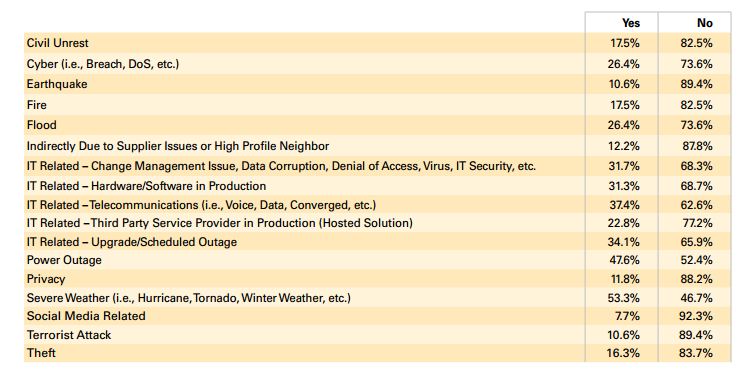5 Simple Tips To Make Strong And Robust Business Continuity Plans
- IT Risk & Cyber Risk
- 23 November 16

Business Continuity Plans
Today’s organizations need comprehensive and robust business continuity planning for swift and effective action in case of a disaster or crisis. As the trade and supply chain have gone global, businesses today expect crisis response to be in seconds, not in hours, to ensure that the ripple impact is minimized. As organizations go digital, an IT failure can cripple the whole supply chain and business operations, causing extreme losses within hours and requiring countless hours to recover from the them. Plans to mitigate IT failures are also affected by the complexity of today’s IT infrastructure. As applications and systems are added based on business and market requirements, newer technologies and infrastructure pose new challenges.
Most businesses leverage cloud based platforms for their enterprise needs at least partially. The cloud helps businesses minimize costs and maximize efficiency; made for speed and convenience, it can scale up and down as needs demand and bring flexibility to business operations. However, the added overhead of managing cloud data centers, planning and performing test exercises across multiple locations and vendors as well as managing a crisis recovery, requires that organizations pay critical attention to their cloud solutions in combination with legacy infrastructure.
Today, an effective business continuity plan requires dynamic collection of information across the extended organization in a continuous manner. Organizations need to overcome the traditional fragmented approach to business continuity and formulate the business continuity strategy that adheres to the following five-point agenda:
1. Champion Business Continuity at the Highest Level
With senior management sponsorship, the business continuity plan will occupy its rightful position, high up in business priorities. This is important for sufficient budget, resourcing and training to be assigned to it. Senior leaders must set the tone at the top by insisting on robust crisis planning and regular reviews as a standard practice rather than a mere formality.
In August, Delta suffered a major IT outage that resulted in a $100 million loss in revenues for the airline. The impact was far-reaching, affecting check-in systems, flight information screens, the airline’s website and smartphone apps. The disruption to customers was extensive as well.
This is just one example of many; unfortunately, downtime of one type or another is a common situation in business. According to the Continuity Insights and KPMG, Global BCM 2016 report, 39 percent of global organizations have estimated the cost of business disruption to be $100,000 or less and 27 percent have estimated business disruptions ranging from $100,000 to $5 million or more in the last 12 months . This highlights the need for robust business continuity planning, championed at the highest level.

Types of Instances and Interruptions in Past Year

2. Review, Update and Test Regularly
The business continuity plan is a living document; it isn’t one to be created, filed and never looked at again. Risks evolve. Exercising the plans on a regularly scheduled basis will ensure businesses keep pace with the changing environment and understand what’s needed to protect critical infrastructure and preserve operations during a physical or virtual attack. Companies must learn from their own experience. Worryingly, according to Forrester and the Disaster Recovery Journal, 33 percent of businesses who had to invoke a business continuity plan, said one lesson learned from the experience was that the plan was out of date. Yet, 60 percent never carry out a full simulation of their business continuity plan for the entire organization; most walk through the plan as a document review.
It is of utmost importance that business continuity plans be reviewed by senior management and the planning team. Also, test results should be periodically evaluated and reported to the board, to assess the nature and scope of any changes to the organization’s business.
3. Include Partners, Suppliers and Third Parties
Companies don’t pay enough attention to the significant role of partners, suppliers and third parties in their business continuity. Deloitte found that over 94 percent of survey respondents had low to moderate confidence in the tools and technology used to manage third party risk and 88 percent felt the same about risk management processes. This, despite 87 percent having experienced disruption in the past three years that involved a third party.
Business continuity planning and disaster recovery has to be part of early third party discussions with responsibilities documented in service level agreements. Plans need to be aligned so that it is clear and easy to identify who does what, and where the handover points are when a plan is executed. The tools and systems used for collaboration must support transparency of information so that both parties are able to work from up to date information and take swift action in the event of a crisis.
4. Prioritize Ongoing Business Operations
The continuity plan should demonstrate that the business understands the priority level of its systems and that mitigating plans are in place to restore core operations as quickly as possible.
In the case of the Delta crisis, the outage was so extensive that it paralyzed business critical operations. The range of problems that can disrupt business – natural disasters, industrial action, cybercrime, IT failures, political or economic upheaval, suppliers ceasing to trade and so on – is so vast, and the systems and operations that can be impacted can be so wide that prioritization is a must.
A cloud-based option provides many benefits as an off-site back-up solution to ensure the efficacy of your continuity plan. However, as you develop your plan, ask yourself if a cloud-based option would increase the efficiency and cost-effectiveness of your plan and cover off essential considerations such as due diligence and service reliability with their provider. Another option is establishing a back-up plan that is independent of the cloud by leveraging personalized file backups, cross-device continuity solutions and communication software. The main aim is to get back faster and limit the amount of time that you’re spending without access to critical systems and information, by having a clearly defined continuity plan in place.
5. Define the Communications Plan Clearly
The business continuity plan has to be absolutely clear on how all stakeholders are going to be kept informed and how to enable upstream and downstream communication channels in times of crisis. Stakeholders include employees at all levels of the organization, such as suppliers, partners and customers.
The goal of the communications plan is to outline the channels and mechanisms for the sharing of information that will support efforts to resolve an issue at hand and limit the extent of its damage. How a company handles a crisis has an enormous impact on how they come out of the incident – people remember how the organization dealt and reacted to the issue and how convincing they were over the company’s efforts to make things right. For this reason, crisis management communications must be engaged at the earliest opportunity.
Service disruption is damaging to all businesses not only in terms of immediate revenue loss but also in the longer term brand and reputational impact. The business continuity plan is an essential, living document that aims to protect the ongoing sustainability of the business. Those that plan and execute well will see better performance in the long-run and be best-placed to weather the storms, whatever form they take.
The original article was published in Cloud Tweaks. You can view the article here.







